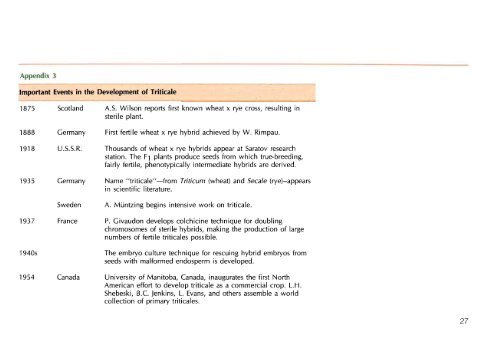U - Search CIMMYT repository
U - Search CIMMYT repository
U - Search CIMMYT repository
Create successful ePaper yourself
Turn your PDF publications into a flip-book with our unique Google optimized e-Paper software.
Appendix 3<br />
Important Events in the Development of Triticale<br />
1875<br />
1888<br />
1918<br />
1935<br />
1937<br />
1940s<br />
1954<br />
Scotland<br />
Germany<br />
U.S.S.R.<br />
Germany<br />
Sweden<br />
France<br />
Canada<br />
A.S. Wilson reports first known wheat x rye cross, resulting in<br />
sterile plant.<br />
First fertile wheat x rye hybrid achieved by W. Rimpau.<br />
Thousands of wheat x rye hybrids appear at Saratov research<br />
station. The Fl plants produce seeds from which true-breeding,<br />
fairly fertile, phenotypically intermediate hybrids are derived.<br />
Name "triticale"-from Triticum (wheat) and Secale (rye)-appears<br />
in scientific literature.<br />
A. MUntzing begins intensive work on triticale.<br />
P. Givaudon develops colchicine technique for doubling<br />
chromosomes of sterile hybrids, making the production of large<br />
numbers of fertile triticales possible.<br />
The embryo culture technique for rescuing hybrid embryos from<br />
seeds with malformed endosperm is developed.<br />
University of Manitoba, Canada, inaugurates the first North<br />
American effort to develop triticale as a commercial crop. L.H.<br />
Shebeski, S.c. Jenkins, L. Evans, and others assemble a world<br />
collection of primary triticales.<br />
27

















